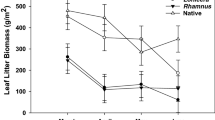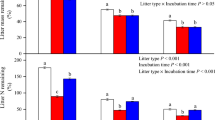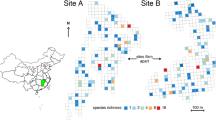Abstract
Earthworm invasion in North American temperate forest reduces forest floor mass, yet the interactions between litter composition, invasive earthworm community composition, and forest floor structure and composition are not well understood. For 2 years, we compared disappearance of leaf litter in field mesocosms in which we manipulated litter composition (monocultures of Quercus rubra, Acer saccharum, and Tilia americana litter, and an equal mixture of all three) and thereby the initial litter chemistry (C, C fractions, N, Ca) in sites with and without the major litter-feeding invasive earthworm species. The disappearance of litter mass followed the same ranking at both the sites: T. americana > equal mixtures > A. saccharum ≥ Q. rubra. However, differences in disappearance rate between the sites depended on litter composition and time. The differences in mass loss among litters of different compositions were greatest at the site invaded by the large litter-feeding earthworm, Lumbricus terrestris, and especially for T. americana and the mixture. Similarly, observed disappearance of the litter mixture was faster than predicted by an additive model at the site with L. terrestris, especially for the higher quality litter component in early summer. Initial litter calcium content was the best predictor (R 2 ≥ 0.90) of overall litter mass remaining each year, supporting the idea of the importance of calcium in forest floor dynamics, especially in the presence of calciferous, invasive earthworms.




Similar content being viewed by others
References
Aber JD, Melillo JM. 1980. Litter decomposition: measuring relative contributions of organic matter and nitrogen to forest soils. Can J Bot 58:416–21.
Alban DH, Berry EC. 1994. Effects of earthworm invasion on morphology, carbon, and nitrogen of a forest soil. Appl Soil Ecol 1:243–9.
Beatty SW, Sholes ODV. 1988. Leaf litter effect on plant species composition of deciduous forest treefall pits. Can J For Res 18:553–9.
Blair JM, Parmalee RW, Allen MF, McCartney DA, Stinner BR. 1997. Changes in soil N pools in response to earthworm population manipulations in agroecosystems with different N sources. Soil Biol Biochem 29(3/4):361–7.
Blair JM, Parmalee RW, Beare MH. 1990. Decay rates, nitrogen fluxes, and decomposer communities of single- and mixed-species foliar litter. Ecology 71(5):1976–85.
Bocock KL, Gilbert JW. 1957. The disappearance of leaf litter under different woodland conditions. Plant Soil 9:179–85.
Bohlen PJ, Edwards CA, Zhang Q, Parmelee RW, Allen M. 2002. Indirect effects of earthworms on microbial assimilation of labile carbon. Appl Soil Ecol 20(3):255–61.
Bohlen PJ, Groffman PM, Fahey TJ, Fisk MC, Suárez E, Pelletier DM, Fahey RT. 2004a. Ecosystem consequences of exotic earthworm invasion of north temperate forests. Ecosystems 7(1):1–12.
Bohlen PJ, Pelletier DM, Groffman PM, Fahey TJ, Fisk MC. 2004b. Influence of earthworm invasion on redistribution and retention of soil carbon and nitrogen in northern temperate forests. Ecosystems 7(1):13–27.
Bohlen PJ, Parmelee RW, McCartney DA, Edwards CA. 1997. Earthworm effects on carbon and nitrogen dynamics of surface litter in corn agroecosystems. Ecol Appl 7(4):1341–9.
Bormann FH, Likens GE. 1979. Pattern and process in a forested ecosystem. New York: Springer.
Cadish G, Giller KE. 1997. Driven by nature: plant litter quality and decomposition. Wallingford: CAB International. 432 pp.
Canti MG, Piearce TG. 2003. Morphology and dynamics of calcium carbonate granules produced by different earthworm species. Pedobiologia 47:511–21.
Côté B, Fyles JW. 1994. Leaf litter disappearance of hardwood species of southern Québec: interaction between litter quality and stand type. Ecoscience 1(4):322–8.
Cothrel SR, Vimmerstedt JP, Kost DA. 1997. In situ recycling of urban deciduous litter. Soil Biol Biochem 29(3–4):295–8.
Coûteaux M-M, Bottner P, Berg B. 1995. Litter decomposition, climate and litter quality. Trends Ecol Evol 10:63–6.
Crang MG, Holsen RC, Hitt JB. 1968. Calcite production in mitochondria of earthworm calciferous glands. Bioscience 18:299.
Curry JP, Schmidt O. 2007. The feeding ecology of earthworms—a review. Pedobiologia 50:463–77.
Domínguez J, Bohlen PJ, Parmelee RW. 2004. Earthworms increase nitrogen leaching to greater soil depths in row crop agroecosystems. Ecosystems 7:672–85.
Edwards CA, Lofty JR. 1977. Biology of earthworms. London: Chapman & Hall.
Eisenhauer N, Partsch S, Parkinson D, Scheu S. 2007. Invasion of a deciduous forest by earthworms: changes in soil chemistry, microflora, microarthropods and vegetation. Soil Biol Biochem 39:1099–110.
Facelli JM, Pickett STA. 1991. Plant litter: Its dynamics and effects on plant community structure. Bot Rev 52:1–32.
Ferrari JB. 1999. Fine-scale patterns of leaf litterfall and nitrogen cycling in an old-growth forest. Can J For Res 29:291–302.
Fisk MC, Fahey TJ, Groffman PM, Bohlen PJ. 2004. Earthworm invasion, fine-root distributions, and soil respiration in north temperate forests. Ecosystems 7(1):55–62.
Frelich L, Hale C, Scheu S, Holdsworth A, Heneghan L, Bohlen P, Reich P. 2006. Earthworm invasion into previously earthworm-free temperate and boreal forests. Biol Invasions 8(6):1235–45.
Frelich LE, Calcote RR, Davis MB, Pastor J. 1993. Patch formation and maintenance in an old-growth hemlock—hardwood forest. Ecology 74(2):513–27.
Gartner TB, Cardon ZG. 2004. Decomposition dynamics in mixed-species leaf litter. Oikos 104(2):230–46.
Grimm EC. 1984. Fire and other factors controlling the Big Woods vegetation of Minnesota in the mid-nineteenth century. Ecol Monogr 54(3):291–311.
Groffman PM, Bohlen PJ, Fisk MC, Fahey TJ. 2004. Exotic earthworm invasion and microbial biomass in temperate forest soils. Ecosystems 7:45–54.
Gundale MJ. 2002. Influence of exotic earthworms on the soil organic horizon and the rare fern Botrychium mormo. Conserv Biol 16(6):1555–61.
Hale CM, Frelich LE, Reich PB. 2004. Allometric equations for estimation of ash-free dry mass from length measurements for selected European earthworm species (Lumbricidae) in the western Great Lakes region. American Midland Naturalist 151:179–85.
Hale CM, Frelich LE, Reich PB, Pastor J. 2005. Effects of European earthworm invasion on soil characteristics in northern hardwood forests of Minnesota, USA. Ecosystems 8(8):911–27.
Hale CM, Frelich LE, Reich PB. 2006. Changes in hardwood forest understory plant communities in response to European earthworm invasions. Ecology 87:1637–49.
Hättenschwiler S, Bretscher D. 2001. Isopod effects on decomposition of litter produced under elevated CO2, N deposition and different soil types. Glob Change Biol 7(5):565–79.
Hättenschwiler S, Gasser P. 2005. Soil animals alter plant litter diversity effects on decomposition. PNAS 102(5):1519–24.
Hättenschwiler S, Tiunov AV, Scheu S. 2005. Biodiversity and litter decomposition in terrestrial systems. Annu Rev Ecol Syst 36:191–218.
Hazelhoff L, VanHoof P, Imeson AC, Kwaad FJPM. 1981. The exposure of forest soil to erosion by earthworms. Earth Surf Proc Land 6:235–50.
Heath GW, Arnold MK, Edwards CA. 1966. Studies in leaf litter breakdown. I. Breakdown rates among leaves of different species. Pedobiologia 6:1–12.
Hendriksen NB. 1990. Leaf litter selection by detritivore and geophagous earthworms. Biol Fertil Soils 10:17–21.
Hendrix PF, Callaham MA, Drake JM, Ching-Yu H, James SW, Snyder BA, Zhang W. 2008. Pandora’s box contained bait: the global problem of introduced earthworms. Annu Rev Ecol Evol Syst 39:593–613.
Hobbie SE, Reich PB, Oleksyn J, Ogdahl M, Zytkowiak R, Hale C, Karolewski P. 2006. Tree species effects on decomposition and forest floor dynamics in a common garden experiment. Ecology 87(9):2288–97.
Holdsworth AR, Frelich LE, Reich PB. 2007a. Effects of earthworm invasion on plant species richness in northern hardwood forests. Conserv Biol 21(4):997–1008.
Holdsworth AR, Frelich LE, Reich PB. 2007b. Regional extent of an ecosystem engineer: earthworm invasion in northern hardwood forests. Ecol Appl 17(6):1666–77.
Holdsworth AR, Frelich LE, Reich PB. 2008. Litter decomposition in earthworm-invaded northern hardwood forests: role of invasion degree and litter chemistry. Ecoscience 15(4):536–44.
Judas M. 1990. The development of earthworm populations following manipulation of the canopy leaf litter in a beechwood on limestone. Pedobiologia 34:247–55.
Knollenberg WG, Merritt RW, Lawson DL. 1985. Consumption of leaf litter by Lumbricus terrestris (Oligochaeta) on a Michigan woodland floodplain. Am Midl Nat 113:1–6.
Lawrence AP, Bowers MA. 2002. A test of the ‘hot’ mustard extraction method of sampling earthworms. Soil Biol Biochem 34(4):549–52.
Littell RC, Milliken GA, Stroup WW, Wolfinger RD. 1996. SAS system for mixed models. Cary (NC): SAS Institute Inc. 633 pp.
Liu ZG, Zou XM. 2002. Exotic earthworms accelerate plant litter decomposition in a Puerto Rican pasture and a wet forest. Ecol Appl 12(5):1406–17.
Loss SR, Blair RB. 2011. Reduced density and nest survival of ground-nesting songbirds relative to earthworm invasions in northern hardwood forests. Conserv Biol 25(5):983–92.
McClaugherty C, Berg B. 1987. Cellulose, lignin and nitrogen concentrations as rate regulating factors in late stages of forest litter decomposition. Pedobiologia 30:101–12.
McClaugherty CA, Pastor J, Aber JD, Melillo JM. 1985. Forest litter decomposition in relation to soil nitrogen dynamics and litter quality. Ecology 66(1):266–75.
McLean MA, Parkinson D. 1998. Impacts of the epigeic earthworm Dendrobaena octaedra on microfungal community structure in pine forest floor: a mesocosm study. Appl Soil Ecol 8(1–3):61–75.
McLean MA, Parkinson D. 2000. Field evidence of the effects of the epigeic earthworm Dendrobaena octaedra on the micro-fungal community in pine forest floor. Soil Biol Biochem 32:351–60.
Meentemeyer V. 1978. Macroclimate and lignin control of litter decomposition rates. Ecology 59(3):465–72.
Melillo JM, Aber JD, Muratore JF. 1982. Nitrogen and lignin control of hardwood leaf litter decomposition dynamics. Ecology 63(3):621–6.
MNDNR. 1999. A guide to Minnesota’s Scientific and Natural Areas. St. Paul: Minnesota Department of Natural Resources. 194 pp.
Nielson GA, Hole FD. 1964. Earthworms and the development of coprogenous A1 horizons in forest soils of Wisconsin. Soil Sci Soc Am Proc 28:426–30.
Nordström S, Rundgren S. 1974. Environmental factors and lumbricid associations in southern Sweden. Pedobiologia 14:1–27.
Nuzzo VA, Maerz JC, Blossey B. 2009. Earthworm invasion as the driving force behind plant invasion and community change in northeastern North American forests. Conserv Biol 23(4):966–74.
Orazova MK, Semenova TA, Tiunov AV. 2003. The microfungal community of Lumbricus terrestris middens in a linden (Tilia cordata) forest. Pedobiologia 47(1):27–32.
Orndorff KA, Lang GE. 1981. Leaf litter redistribution in a West Virginia hardwood forest. J Ecol 69:225–35.
Pastor J, Aber JD, McClaugherty CA, Melillo JM. 1982. Soils and vegetation of Blackhawk Island, Wisconsin. Am Midl Nat 108:266–77.
Pastor J, Aber JD, McClaugherty CA, Melillo JM. 1984. Aboveground production and N and P cycling along a nitrogen mineralization gradient on Blackhawk Island, Wisconsin. Ecology 65(1):256–68.
Raw F. 1962. Studies of earthworm populations in orchards. I. Leaf burial in apple orchards. Ann Appl Biol 55:389–404.
Reich PB, Grigal DF, Aber JD, Gower ST. 1997. Nitrogen mineralization and productivity in 50 hardwood and conifer stands on diverse soils. Ecology 78(2):335–47.
Reich PB, Oleksyn J, Modrzynski J, Mrozinski P, Hobbie SE, Eissenstat DM, Chorover J, Chadwick OA, Hale CM, Tjoelker MG. 2005. Linking litter calcium, earthworms and soil properties: a common garden test with 14 tree species. Ecol Lett 8(8):811–18.
Robertson JD. 1936. The function of calciferous glands of earthworms. J Exp Biol 13:279–97.
SAS Institute Inc. 2002. JMP, version 5.0.1a. Cary (NC): SAS Institute.
Satchell JE, Lowe DG. 1966. Selection of leaf litter by Lumbricus terrestris. In: Graff O, Satchell JE, Eds. Progress in soil biology. Amsterdam: North Holland Publishing Company. p 102–19.
Satchell JE. 1967. Lumbicidae. In: Burges A, Raw F, Eds. Soil biology. London: Academic Press. p 259–322.
Staaf H. 1987. Foliage litter turnover and earthworm populations in three beech forests of contrasting soil and vegetation types. Oecologia 72:58–64.
Straube D, Johnson EA, Parkinson D, Scheu S, Eisenhauer N. 2009. Nonlinearity of effects of invasive ecosystem engineers on abiotic soil properties and soil biota. Oikos 118:885–96.
Suárez ER, Fahey TJ, Yavitt JB, Groffman PM, Bohlen PJ. 2006. Patterns of litter disappearance in a northern hardwood forest invaded by exotic earthworms. Ecol Appl 16(1):154–65.
Suárez ER, Pelletier DM, Fahey TJ, Groffman PM, Bohlen PJ, Fisk MC. 2004. Effects of exotic earthworms on soil phosphorus cycling in two broadleaf temperate forests. Ecosystems 7(1):28–44.
Swift MJ, Heal OW, Anderson JM. 1979. Decomposition in terrestrial ecosystems. Oxford: Blackwell Scientific Publications, Ltd.
Tietema A. 1998. Microbial carbon and nitrogen dynamics in coniferous forest floor material collected along a European nitrogen deposition gradient. For Ecol Manage 101(1–3):29–36.
Vitousek PM, Walker LR. 1989. Biological invasion by Myrica Faya in Hawai’i: plant demography, nitrogen fixation, ecosystem effects. Ecol Monogr 59(3):247–65.
Zimmer M, Kautz G, Topp W. 2005. Do woodlice and earthworms interact synergistically in leaf litter decomposition? Funct Ecol 19(1):7–16.
Acknowledgments
This research was supported by the National Science Foundation (DEB-0075236), the Minnesota Department of Natural Resources, the University of Minnesota Center for Hardwood Ecology, the Wilderness Research Foundation, and a University of Minnesota Doctoral Dissertation Fellowship. We thank M. Ogdahl, W. Eddy, B. Boyce, N. Worm, S. Schmidt, J. Yahnke, C. Mueller, D. Martin, J. Busse, and the Hobbie Lab for assistance with field and lab work. S. E. Hobbie, P. F. Hendrix, N. Eisenhauer, and S. Ziegler provided valuable comments on the manuscript. This study’s experiments comply with the current laws of the United States.
Author information
Authors and Affiliations
Corresponding author
Additional information
Author Contributions
ARH lead study conception and design, data collection and analysis, and wrote the manuscript. LEF and PBR contributed to study conception and design, data analysis, and writing of the manuscript.
Electronic supplementary material
Below is the link to the electronic supplementary material.
Rights and permissions
About this article
Cite this article
Holdsworth, A.R., Frelich, L.E. & Reich, P.B. Leaf Litter Disappearance in Earthworm-Invaded Northern Hardwood Forests: Role of Tree Species and the Chemistry and Diversity of Litter. Ecosystems 15, 913–926 (2012). https://doi.org/10.1007/s10021-012-9554-y
Received:
Accepted:
Published:
Issue Date:
DOI: https://doi.org/10.1007/s10021-012-9554-y




